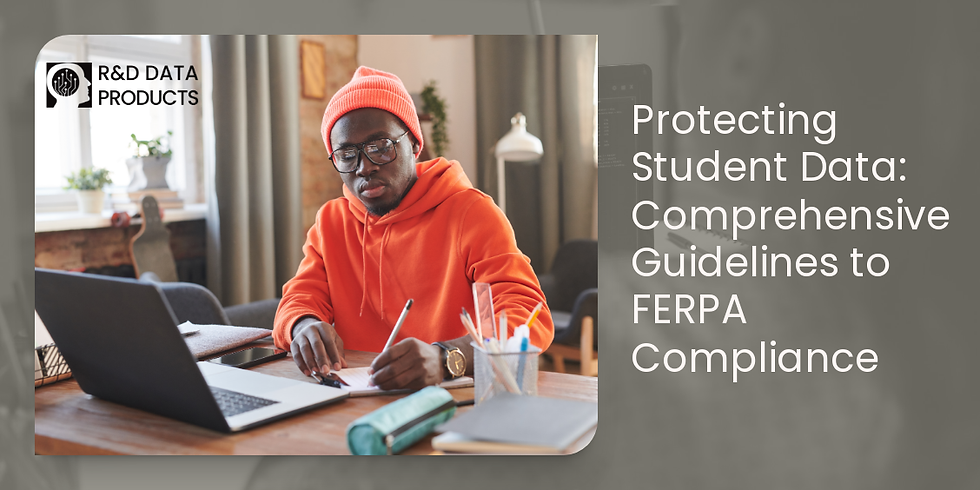Protecting Student Data: Comprehensive Guidelines to FERPA Compliance
- Dillon Diatlo
- Jun 19
- 3 min read
Updated: Aug 15

Data breaches, ransomware attacks, and phishing scams are increasing. Protecting student information is harder than ever. This issue goes beyond cybersecurity; it involves compliance, trust, and responsibility towards communities.
Education IT leaders must prioritize the safety of student data and comply with FERPA (the Family Educational Rights and Privacy Act). This blog examines FERPA regulations from an IT perspective. We'll discuss real-world data protection and how R&D Data Products can assist K-12 districts and higher education institutions with network performance tuning. Our aim is to provide future-proof, practical solutions for FERPA compliance.
Table of Contents
1. What Is FERPA? Why It Matters for School IT Teams
FERPA is a federal law that grants parents and eligible students rights over their educational records. It also dictates how schools manage, store, and share personally identifiable information (PII).
For IT teams, this law entails:
Preventing unauthorized access to student data
Tracking who accesses sensitive information
Encrypting data during transit and when stored
Maintaining audit trails and breach reporting mechanisms
Non-compliance with FERPA can result in lost federal funding and significant damage to public trust.
2. Common FERPA Compliance Gaps in School Networks
Several gaps may put educational institutions at risk. Here are some common compliance issues:
Unsecured Data Storage: Student records stored on outdated servers or local drives are vulnerable to breaches.
Weak Access Controls: When too many users possess admin privileges or share passwords, the data is at greater risk.
Unencrypted Traffic: Data transmitted over unsecured Wi-Fi or unsegmented networks can be intercepted, exposing sensitive information.
Lack of Monitoring: Absence of logging or alerting means you may not know a breach has occurred until it's too late.
3. Technical Safeguards for FERPA Compliance
Implementing technical safeguards is essential for FERPA compliance. Here are critical measures to consider:
Role-Based Access Controls (RBAC): Access should be assigned based on job responsibilities. For instance, only counselors should view disciplinary records, while only admins should access Student Information Systems (SIS).
Network Segmentation: Keep student databases separate from general user traffic. This limits movement if an attacker gains access.
Multi-Factor Authentication (MFA): Implement MFA for teachers, staff, and IT admins to access cloud platforms, SIS, and email systems.
Data Encryption: Encrypt student data both at rest (on storage devices) and in transit (across the network).
Log Management & Alerts: Monitor access logs and set up alerts for any suspicious activity or unauthorized access attempts.
The Importance of Data Protection
A comprehensive understanding of FERPA compliance protects educational institutions. Implementing the above safeguards ensures that student information is secure, maintaining trust with the community.
4. Hardware and Tools That Help Protect Student Data
At R&D Data Products, we don’t just discuss FERPA compliance; we implement effective solutions. We partner with leading hardware vendors to deliver practical and compliant solutions for schools of all sizes.
Fortinet: Use FortiGate firewalls to enforce network segmentation and SSL inspection. FortiAuthenticator supports MFA and access control management.
Palo Alto Networks: Their next-gen firewalls and the Palo Alto Prisma Access platform facilitate identity-aware traffic inspection, comprehensive logging, and remote access protection.
Extreme Networks: This provider enables traffic segmentation and role-based policies at the switch level, offering centralized visibility into access patterns. (Learn more: What does Extreme Networks do?)
Scale Computing: They provide a secure and reliable storage infrastructure with high availability, ensuring that protected student data remains intact. (More about Scale)
Zoom: Video calls can contain PII. Zoom's admin tools enable school IT to control accessibility, enforce MFA, and govern user visibility.
We assist in identifying the best solutions and configuring them correctly from the start.
5. Summary Table: Protect Student Data FERPA Guidelines Checklist
STEP | ACTION ITEM | R&D RECOMMENDED TOOLS |
Control Access | Enforce RBAC, eliminate shared logins | Fortinet, Palo Alto Networks |
Secure the Network | Segment traffic, inspect encrypted connections | Fortinet, Extreme Networks |
Encrypt Student Data | Protect data in transit and at rest | Scale Computing, Fortinet |
Enforce MFA | Add MFA to SIS, email, and cloud platforms | FortiAuthenticator, Prisma Access |
Monitor Access Logs | Set alerts, track anomalies in usage | Palo Alto Networks, Fortinet |
Need Help Locking Down Your Student Data?
Let's make it FERPA-compliant and future-proof. R&D Data Products has decades of experience helping school districts in New Jersey, New York, and Pennsylvania protect what matters most.
Reach out for a consultation today. Contact R&D Data Products



Comments